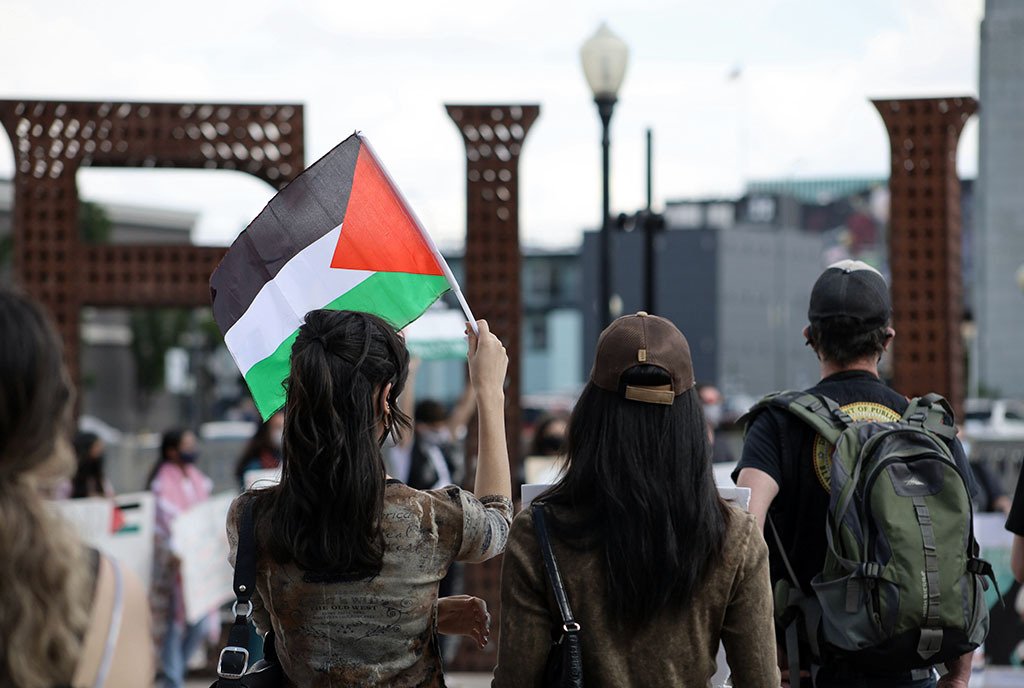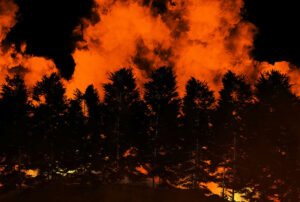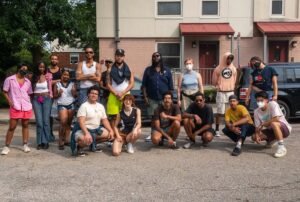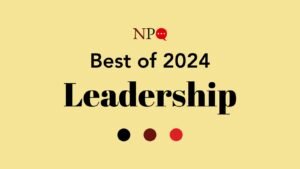
In early November, 300,000 people from at least 22 states flooded the streets of Washington, DC. They rallied between the Capitol building and the White House, and marched onward, demanding a ceasefire in the war between Israel and Hamas, to lift the blockade on Gaza, and to end US aid to Israel. Cosponsored by nine organizations and endorsed by hundreds of others, the rally and march brought members and supporters from as far away as Maine, Florida, and Illinois to the capital. It was the largest demonstration of solidarity with Palestine that the United States has ever seen.
The movement for a free Palestine in the United States has ebbed and flowed, as all liberation movements do. But the brutality of the Israeli bombing campaign and ground invasion of Gaza (and escalating settler violence in the West Bank) is so egregious that people who might otherwise not have spoken out are now risking doxxing and harassment campaigns to stand up for the Palestinian cause.
“We know that the streets are with us.”
Media coverage of the many rallies, marches, and protests across American cities—and around the world—since October 7 has often been distorted or censored. This makes it difficult to get a sense of who is organizing this movement, their understanding of the moment, and to what extent the outpouring of support for Palestine might even exceed the capacity of the movement as it existed before last month.
All of the activists I spoke to for this story expressed a sense of exhaustion, grief, and quiet, cautious optimism: exhaustion because the crisis in Palestine has reached a level of intensity unprecedented in their adult lifetimes; grief at the scale of death and suffering; and quiet, cautious optimism at the breadth and depth of support that people have shown for the cause, even as anti-Palestinian repression continues to escalate.
“We know that the streets are with us,” Nadya Tannous of the Palestinian Youth Movement (PYM) told me. “Ceasefire is the bare minimum of what people need to find reprieve, to find critical resources such as food and water, to look for their loved ones under the rubble, to bury their dead.” She continued: “But that must be connected to the demand to lift the blockade on Gaza…[and] ending all US aid to Israel.”
The Movement for a Free Palestine
For the past decade or so, a generation of young organizers have been building the organizational infrastructure necessary to meet a moment like this one, wherein the ongoing violence of occupation and apartheid has intensified in response to the Hamas-led attacks of October 7. These recent events put new pressures on what they can do, stretching their emotional, political, and financial capacities ever thinner, even as they wake up every day to new obscenities and horrors in Palestine itself.
Various activists, both Palestinian and non-Palestinian, pointed to the key role of Jewish-led anti-Zionist organizations like Jewish Voice for Peace (JVP) in making this mass movement possible: high-profile actions, often involving elected officials and celebrities—like the sit-in at the Capitol Rotunda in Washington, DC, or the occupation of Grand Central Station in New York City—have drawn media attention and disrupted conventional narratives that reduce the conflict to religious intolerance.
“We think it has made a tremendous impact, although not on the decision-makers at the top of the Democratic Party in Washington. We’re still waiting for them to open their eyes, open their ears, and have one fiber of political, if not moral, sense that comes alive,” Rosalind Petchesky, professor emeritus at CUNY’s Hunter College, told me a day after she and hundreds of other JVP activists assembled at the base of the Statue of Liberty.
“It was extraordinary to have 500 people in a mass demonstration, at the Statue of Liberty, wearing our t-shirts that say, ‘Not in Our Name,’ ‘Ceasefire Now,’ arriving on ferries at different times, convening around the pedestal, dropping colorful, vibrant banners—all done with stealth. The police didn’t know,” Petchesky said. “It was gorgeously choreographed, thanks to the amazing, strategic, and aesthetic sensibility of a small group of members of JVP NYC. To me, as an elderly person, involved in many demonstrations for decades—I’m older than the state of Israel—to me, these young people are geniuses. I’ve never encountered the level of imagining, envisioning, of my dear young comrades and friends in JVP NYC.”
Jewish Voice for Peace has become a linchpin in the wider Palestine solidarity movement in the United States: there is immense strategic value in the moral authority that anti-Zionist Jews can invoke when speaking out against Israel, to say nothing of the absurd corners that organizations like the Anti-Defamation League paint themselves into accusing anti-Zionist Jews of anti-Semitism. In fact, JVP is just one of several anti-Zionist Jewish groups that have committed themselves to Palestinian liberation, along with other faith-based groups—Jewish, Christian, and Muslim alike—unions, community groups, and political organizations, Palestinian-led and non-Palestinian-led. The coalitions among these organizations do not necessarily spring forth into existence simply out of necessity but rather must be built.
“There has been plenty of work put in to be ready for moments like this,” Olivia Katbi, the North America coordinator for the Boycott, Divestment, Sanctions (BDS) movement, told me. “It takes years of work to build a coalition. There are coalitions that have been around forever, and there are new coalitions that are forming.”
Modeled after the anti-apartheid activism of the 1980s, BDS is perhaps the most high-profile tactic of the Palestine solidarity movement in the United States, subject to criminalization and slander wherever it is pursued. “The BDS movement has a long-term strategy for a long-term crisis,” Katbi said. “This is not a new crisis. An escalation like this happens every few years; this is one of the worst, but it’s not anything new.”
“It’s great to see all the energy right now on the streets, people doing sit-ins, blocking highways, occupying members of Congress’s offices, but eventually that momentum is gonna die down, as we see with all movements that turn out massive numbers of people into the streets. It’s just not something people can do long-term. And we will see a lot of those people ask, ‘What’s next? What can I do?’” Katbi said.
The value of the BDS strategy is its adaptability to different moments of struggle: between periods of escalation, activists are building the organizational infrastructure to support people passing resolutions in their union, winning a church congregation over to divestment, reforming a pension fund, or passing legislation. For Katbi, the devastation of the past month is not a reason to change tack but rather to stay the course: “Now is the time to push for BDS, when so many people are paying attention.”
Sign up for our free newsletters
Subscribe to NPQ's newsletters to have our top stories delivered directly to your inbox.
By signing up, you agree to our privacy policy and terms of use, and to receive messages from NPQ and our partners.
Apartheid Is Not Sustainable
Times of crisis also offer the chance to advance arguments that otherwise wouldn’t get a hearing, such as the financial implications that come with US support of Israel. Less than a month after a narrowly avoided government shutdown, President Biden asked Congress to pass a $105 billion defense package, including $14.3 billion in aid for Israel. As the Palestinian death toll since October 7 ticks past 11,000, organizers are pointing out that spending more money on war is not only morally wrong but economically unsound. “Not only is it a very clear-cut moral issue, but it’s financially irresponsible,” Katbi said. “Even before this latest escalation, it was very clear that divesting from Israel made sense financially.” Earlier this year, institutions like Morgan Stanley and the S&P 500 sounded alarms about the financial implications of the Netanyahu regime’s so-called judicial reforms.
“A regime of apartheid is not sustainable. It’s not a sound financial investment,” Katbi told me. “So many of these divestment campaigns go up against a fiduciary argument. The people making the decision say, ‘Well, we can’t divest based on a moral or ethical reason; there has to be a financial reason.’ We have that financial reason: it’s not a sound investment to invest in apartheid, just like in South Africa.”
Even as some organizations, like the BDS Movement, remain staunchly committed to their chosen strategy, others have found that they must begin acting in new ways. The Palestinian American Community Center (PACC) in northern New Jersey, for example, is not only continuing its normal programming but has also expanded its efforts: fielding media requests, becoming the de facto spokespeople for the Palestinian cause in the state and connecting reporters to people in Palestine; providing support groups and healing spaces for Palestinian-Americans; holding teach-ins and educational events for the wider public; and organizing protests and press conferences.
“We can’t liberate Palestine if we’re not an empowered community—if we’re not an organized community.”
As a community organization, PACC’s approach to Palestinian liberation is different than that of PYM or BDS. Rania Mustafa, PACC’s executive director, told me, “For so long, the way that people felt connected to their Palestinian heritage was by supporting a humanitarian cause there or sending money back home to their families.” She described the waves of Palestinians who came to the United States, displaced and dispossessed by Israeli settlers and the state, over the course of the 20th century: first in 1948, then in 1967, and again during the Palestinian uprisings—the First and Second Intifadas—between 1987 and 1993. Even as these immigrants assimilated, many maintained their ties to Palestine—often mediated by the fact that they were relatively wealthier than friends and family back home and could afford to send remittances or donate to local NGOs.
About a decade ago, PACC began to shift the emphasis. As Mustafa explained, “Rather than focus on supporting our Palestinian community there, what if we support our Palestinian-American community here? If we empower individuals, we can create an empowered community; if we have an empowered community, we can inform change in our society; if we can inform change in our society, we can see a day where there is a free Palestine and a world free of oppression.” She continued, “We can’t liberate Palestine if we’re not an empowered community—if we’re not an organized community. If each of us are struggling to get by, to exist, we can’t do that. But if we’re a strong community and an empowered community, an organized community, we can inform change both here and there.”
In describing PACC’s approach to coalition building, Mustafa drew a distinction between allyship and solidarity. To be an ally to someone, she said, is transactional: you show up for me because I showed up for you; I support you because it’s the right thing to do, but ultimately your struggle is your own. Solidarity, though, is something else altogether: “Solidarity means this is as important to me as it is to you. It means your liberation is my liberation. There is no ‘your struggle’ and ‘my struggle.’ This is our struggle.”
“Solidarity means this is as important to me as it is to you. It means your liberation is my liberation….This is our struggle.”
Ceasefire Now—And End the Occupation
Nowhere is this clearer than in the longstanding relationship between the Black and Palestinian liberation movements. While Black and Palestinian solidarities stretch back at least to the 1970s, multiple delegations of Black activists, writers, scholars, and culture workers had visited Palestine in the early 2010s, creating networks and relationships between a new generation of organizers and intellectuals. These solidified after the 2014 police killing of Michael Brown in Ferguson, which followed on the heels of the 51-Day War when Israel bombed and invaded Gaza, leaving 2,000 Palestinians dead. As historian Robin D.G. Kelley explained to me, that summer was marked by “the convergence of unremitting state violence that people saw in a very visceral way.”
Just as alliances have been forged among the Palestinians, the Black left, and anti-Zionist Jews from the 1970s through today, they have also been cultivated between Zionists and the Black liberal political class. What is different now, Kelley suggests, is that the Zionist bloc, which reaches into both Democrat and Republican parties, is beginning to come apart. “What we’re seeing here, between the 1970s to 80s versus today, is the shrinking legitimacy of the liberal Black-Zionist alliance,” he told me. “It may not be shrinking in numbers, but it’s losing its moral legitimacy.”
“What we’re seeing now is way more draconian consequences—that are not working,” Kelley said. “This is a sign of desperation: more repression and more refusal.” Threatening people with dismissal, withdrawing job offers, accusing principled anti-Zionists of anti-Semitism, disbanding student groups: this all constitutes the soft power version of what Israel has been doing in Gaza and the West Bank for a long time, he argued. But this ratcheting up of repression has a way of making more radical demands resonate more deeply and widely: “People who are standing up are not simply saying, ‘Ceasefire now.’ They’re saying, ‘Ceasefire now—and end the occupation.’”
Katbi, the BDS coordinator, agreed. “When the BDS Movement first started out,” she said, “Canary Mission [a political organization that compiles information on people and entities it considers to be anti-Israel] came out doxxing college students. There were so many smear campaigns against Palestinian activists and activists for Palestinian rights. That was a scary moment, but I think the longer that that has gone on…I don’t think people are falling for it in the same way. Obviously, the repression is happening, and it’s scary. But I don’t think it has the long-term effects that Israel and Israel’s supporters hoped that it would. It’s just not working anymore.”
The fact that the chilling effect of these harassment campaigns seems to have lessened may mean that more aggressive tactics are on their way. “I would like to tell you that the repression has reached its peak; it hasn’t. The stronger and more effective that your movement becomes, the more desperate the other side gets,” PYM’s Tannous said. “This repression is based on the long history of the war on terror, Islamophobia, the long history of anti-Palestinian racism. It will only have social capital for so long, but it will require sacrifice, courage, and persistence from the Palestinian community, the Muslim community, the Arab community, and all our supporters—everyone who has spoken about our history before the beginning of October—to overcome.”
To speak about that history is itself a courageous act. “Israel wants to destroy the very idea as well as the reality of Palestine and Palestinians,” Petchesky, the scholar and JVP activist, told me. “We feel responsible as Jews because it’s being done in our name and as Americans because it’s being done with our money,” she said. “Our main mission is to speak out as Jews for Palestinian liberation, for justice in Palestine. Many members of JVP have a vision of a shared land, a shared history, but that’s not for us to decide; it’s for Palestinians to figure out.”
Creating the space—in organizations, in the streets, in the media—for Palestinians to deliberate what a free Palestine will look like is the movement’s collective responsibility. “We make sure that Palestinians are at the forefront of the conversation and are essential to the conversation, but that doesn’t mean we’re centering the same opinion all the time. We’re taking people from many different points of view, many different walks of life, and bringing them together,” PACC’s Mustafa said. “But the thing that ties every Palestinian to each other is this idea of liberation. We all have different opinions about how to achieve it and what it looks like, but the thing that ties us together is the idea.”









